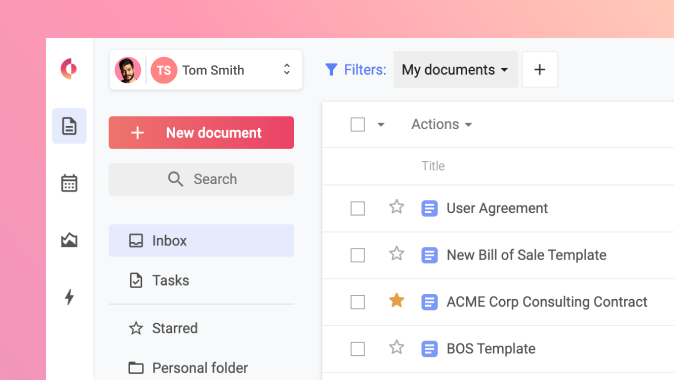Procurement Management Plan in 10 Steps
Handling a company’s procurement is one thing—effectively managing it is quite another. Procurement processes have the power to save time and money while increasing organizational compliance. Yet procurement can often be time-consuming and inefficient. To effectively manage an organization’s procurements, it’s necessary to have a thorough plan based on solid information.
This is a 10-step guide on how to make a procurement plan that will help any procurement professional optimize their processes.
What is a Procurement Management Plan?
A procurement management plan helps define the requirements for a project and effectively manage the steps required to get to the final contract. The plan should be flexible enough to change as acquisition needs are altered, and will address important issues such as which items need to be procured, how contracts will be approved, the criteria decisions will be based on, risk identification, cost determination, and contract lifecycle management, to name a few.
The Role of the Project Manager
The project manager’s responsibility is to clearly define the project from the start and manage it going forward. This will ensure that everyone involved understands the steps necessary to take the project from its initial stages to completion. The project manager’s goal is to ensure the project stays streamlined and easy to manage, so those involved won’t become overwhelmed. In order to accomplish this, it’s necessary for all project team members to work together with the purchasing department and those responsible for approving and managing contracts.
Step 1: Define the Procurement Terms
The first step to start the procurement process is outlining what items will be procured in specific terms. Detail the items and sizes, along with the service it will provide, and the justification for it. For instance, is it a tool that this organization doesn’t make? Is it required for the manufacturing of an item needed to complete the project? If there is any technical information pertinent to the procurement process, it should be listed here.
Next, specify the date the items are required by. Each item will have a different date, depending on where it is needed in the timeline for the project’s completion. Finally, there is likely a list of people who are authorized to approve the purchase of each item. This ensures the approval process isn’t hampered by misunderstandings.
Step 2: Determine Which Type of Agreement to Use
A contract is the agreement between a company and a vendor and specifies how costs will be handled. Fixed price and cost reimbursement (also known as cost-plus) contracts are two broad categories of contracts. There are also time and materials contracts, which are based on fixed hourly billing rates, actual materials costs, and fixed add-on amounts.
In addition to the type of agreement, the specifics of the contract management details should be identified at this point. This generally includes the contract lifecycle management platform processes, including e-signature requirements, approvals, and post-signature management procedures.
Step 3: Identify the Risks
All projects carry risks that could threaten the project’s completion or schedule, and it’s the role of the project manager to identify the ones that pertain to the procurement process. These risks could include things like vendor conflicts, unrealistic schedules, idealistic cost expectations, potential shipping delays, and a vendor’s inability to meet deadlines or perform up to standards.
Step 4: Mitigate the Risks
In order to ensure the success of the project, the plan should include a section to mitigate any of the identified risks. For example, if the specialized subcontractor fails to complete their portion of the project, a replacement contractor should be identified to call. There should also be a section naming who has the authority to approve issue resolution actions for any risks that come up and are not specifically outlined.
Step 5: Cost Determination
In this step, it’s important to outline exactly how the costs associated with the project will be determined. For most procurements, a request for proposal (RFP) will be issued, outlining the needs and asking vendors to provide bids. In their responses, they will outline what products or services they will provide, how they will do the work, their experience in providing the types of goods or services, schedules, and a line-by-line outline of their costs. The initial RFP should be clear about the exact requirements, such as critical schedule dates or cost.
Step 6: Identify Which Forms are to be Used
Many procurement professionals prefer to use standardized forms to ensure the project is more easily managed. Identifying which forms, formats, and templates will be used for the project will ensure there is cohesion within the groups associated with the project, simplify the process, and make the ongoing management of the process easier. A contract lifecycle management platform should have the ability to create forms that people across the organization as well as third parties can use in the procurement process.
Step 7: State the Project Constraints
Identifying the constraints before the project begins will help ensure its successful completion. If limitations aren’t recognized early on, they may hinder the successful completion of the project. Once outlined, these should be taken into consideration every step of the way until the project’s completion. For instance, if the schedule is not negotiable, state it in this section and all personnel will understand that an on-time schedule should dictate their decisions during the process. Some other constraints in relation to the procurement process can be cost, scope, limited resources, and technical specification.
Step 8: Contract Approval Rules
This section outlines the process by which contracts will be approved. First include the steps that lead up to approval, such as a review of all bids and proposals, as well as a service and cost analysis. Then include the names, roles, and order in which decision makers will review and approve the contracts. Creating an approval workflow will ensure that each contract is reviewed and approved in an appropriate manner. A contract lifecycle management platform should offer workflow capabilities that streamline these approvals to make the agreements easier.
Step 9: Identify the Decision Criteria
In this step of the procurement management process, clearly outline the criteria the review board will use to decide which vendor to award the contract to. For example, items like the vendor’s ability to meet the schedule, cost, quality of the work or product offered, performance history of the vendor, and compliance of each vendor to the RFP will likely impact the final decision.
Step 10: Create a Vendor Management Plan
Part of the procurement management plan should be managing the vendors themselves. Draft an outline to ensure the required products or services are delivered on schedule and with the proper levels of quality. Include how often the project manager should meet with the purchasing department and vendors, how they will meet, the purpose of the meetings, and what each meeting should accomplish. These meetings will keep the project manager informed about the progress of the procured products or services.
Finally, establish performance metrics for each vendor involved with the project. Rate them on the quality of the product or service, their delivery as it pertains to the schedule, the final cost, and other metrics important for evaluating the vendor’s performance on the project. These ratings will help identify areas that can be improved in the process, as well as provide critical data when considering the vendors for future projects.



